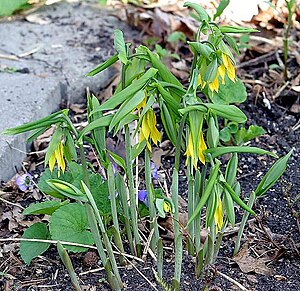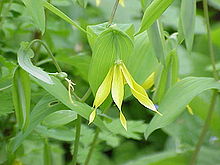Uvularia
| Uvularia | ||||||||||||
|---|---|---|---|---|---|---|---|---|---|---|---|---|

Hanging gold bell ( uvularia grandiflora ) |
||||||||||||
| Systematics | ||||||||||||
|
||||||||||||
| Scientific name | ||||||||||||
| Uvularia | ||||||||||||
| L. |
The plant genus Uvularia , sometimes also called golden bell , gold seal, golden bell , suppository or mourning bell, belongs to the timeless family (Colchicaceae). There are about five species that are only found in eastern North America .
description





Appearance and leaves
Uvularia species grow as perennial herbaceous plants . These geophytes form underground, short to long rhizomes as persistence organs , on which there are some fibrous or thickened roots. The parts of the plant are hairy or hairless. The stalk, which is strongly angular or round in cross section, is simple or has branching.
The alternate arranged on the stem leaves are sessile, depending on the section or mixed. The leathery or membranous leaf blade is oblong-linear to oblong-ovoid. There is a parallel nerve.
Inflorescence and flower
The flowering period is from spring to early summer. Per stem or branch, there is usually one to a maximum of four flowers above a terminal or apparently lateral hanging inflorescence stem, depending on the species. In the upper area there are parchment-like bracts .
The hermaphrodite flowers are threefold. The six identical bracts are free, overlap like roof tiles and stand together like a bell. The early falling bracts are linear to narrowly elongated with a blunt to pointed upper end. The colors of the bracts range from green to whitish-yellow and straw-yellow to golden-yellow, depending on the species. Nectar is secreted on the bracts . There are two circles with three stamens each. The bare stamens that are free or only briefly overgrown at the base of the bracts are dimorphic, so only the three stamens of one stamen circle look the same. There are connections and the anthers are linear-elongated and curved outwards. Three carpels are rounded to a cross-sectionally triangular or sharp, upper permanent, dreikammerigen ovary grown, which may be pedunculated. The stylus ends in a three-lobed scar, with the scar lobes bulging outwards when they are capable of being pollinated.
Fruit and seeds
The sessile or stalked, loculicidal capsule fruits are greenish to yellowish brown when ripe, open slowly and contain one to three seeds per fruit compartment. The fruit skin is leathery to almost membranous.
The brownish-red seeds are spherical to egg-shaped. The aril is different depending on the species.
Chromosome numbers
Basic chromosome numbers are x = 6 or 7.
Systematics and distribution
The Uvularia species are native to eastern North America.
The genus Uvularia was established in 1753 by Carl von Linné in Species Plantarum , 1, pp. 304-305. The type is Uvularia perfoliata . The generic name Uvularia is derived from the Latin word uvula , the medical word for uvula , this refers to the fact that the flowers hang like this organ; It was previously assumed that the parts of plants could treat diseases in this organ. Synonyms for Uvularia L. are: Uffenbachia Heist. ex Fabr. , Oakesia S. Watson nom. illeg., Oakesiella Small .
The genus Uvularia belongs to the tribe Uvularieae in the family Colchicaceae . It used to be classified in the families Convallariaceae, Liliaceae or Uvulariaceae. The genus Uvularia L. is divided into two sections: Uvularia sect. Oakesiella (Small) Wilbur with seated and Uvularia sect. Uvularia with streaked leaves.
There are five Uvularia typologies:
- Uvularia floridana Chapm. : It thrives in species-rich hardwood forests and on alluvial areas at altitudes between 0 and 100 meters in the US states of Alabama , Florida , Georgia , Mississippi and South Carolina . The number of chromosomes is 2n = 12.
- Hanging gold bell ( Uvularia grandiflora Sm. ): It thrives in species-rich moist forests on calcareous to neutral soils at altitudes between 0 and 1100 meters and is widespread in eastern Canada and the eastern United States. The number of chromosomes is 2n = 14.
- Small golden bell ( Uvularia perfoliata L. ): It thrives in deciduous forests and highland thickets on acidic to neutral soils at altitudes between 0 and 1000 meters; it occurs in Ontario, Canada , and is widespread from the eastern United States to eastern Texas. The number of chromosomes is 2n = 14.
- Uvularia puberula Michx. : It thrives in humid to dry, open forests at elevations between 0 and 900 meters and is widespread in the eastern United States from New York to South Carolina. The number of chromosomes is 2n = 14.
- Upright gold bell ( Uvularia sessilifolia L. ): It thrives in moist hardwood forests and alluvial areas in the thicket and northward into xeric forests at altitudes between 0 and 1000 meters and is in the central and eastern Canada and the central and eastern United States widespread. The number of chromosomes is 2n = 14.
use
The young shoots of Uvularia perfoliata and Uvularia sessilifolia are eaten cooked as a tasty substitute for asparagus. The subterranean plant parts of Uvularia sessilifolia are used to make diet drinks.
The medicinal effects of Uvularia grandiflora , Uvularia perfoliata, and Uvularia sessilifolia have been studied.
Uvularia grandiflora and Uvularia perfoliata are used as an ornamental plant in the temperate latitudes .
swell
- Frederick H. Utech & Shoichi Kawano: Uvularia , p. 147 - the same text online as the printed work , Flora of North America Editorial Committee (Ed.): Flora of North America North of Mexico , Volume 26 - Magnoliophyta: Liliidae: Liliales and Orchidales , Oxford University Press, New York and Oxford, 2002. ISBN 0-19-515208-5 (Section Description, Distribution and Systematics)
- Kazuhiko Hayashi, Seiji Yoshida, Hidetoshi Kato, Frederick H. Utech, Dennis F. Whigham & Shoichi Kawano: Molecular Systematics of the Genus Uvularia and Selected Liliales Based upon mat K and rbc L Gene Sequence Data Plant Species Biology , Volume 13, Issue 2 -3, 1998, pp. 129-146: doi: 10.1111 / j.1442-1984.1998.tb00254.x
Individual evidence
- ↑ a b Gordon Cheers (Ed.): Botanica. The ABC of plants. 10,000 species in text and images . Könemann Verlagsgesellschaft, 2003, ISBN 3-8331-1600-5 (therein pages 910-911).
- ↑ a b c d e f g h Rafaël Govaerts (Ed.): Uvularia. In: World Checklist of Selected Plant Families (WCSP) - The Board of Trustees of the Royal Botanic Gardens, Kew . Retrieved June 29, 2018.
- ↑ a b c d e f g h i j k Frederick H. Utech & Shoichi Kawano: Uvularia , p. 147 - same text online as the printed work , Flora of North America Editorial Committee (ed.): Flora of North America North of Mexico , Volume 26 - Magnoliophyta: Liliidae: Liliales and Orchidales , Oxford University Press, New York and Oxford, 2002. ISBN 0-19-515208-5
- ↑ First publication scanned at biodiversitylibrary.org .
- ^ Uvularia at Tropicos.org. Missouri Botanical Garden, St. Louis, accessed March 14, 2013.
- ^ Uvularia in the Germplasm Resources Information Network (GRIN), USDA , ARS , National Genetic Resources Program. National Germplasm Resources Laboratory, Beltsville, Maryland. Retrieved March 14, 2013.
- ↑ a b c Walter Erhardt among others: The great pikeperch. Encyclopedia of Plant Names . Volume 2, page 1802. Verlag Eugen Ulmer, Stuttgart 2008. ISBN 978-3-8001-5406-7
- ↑ a b Uvularia grandiflora , Uvularia perfoliata and Uvularia sessilifolia at Plants for a Future . Retrieved March 14, 2013.